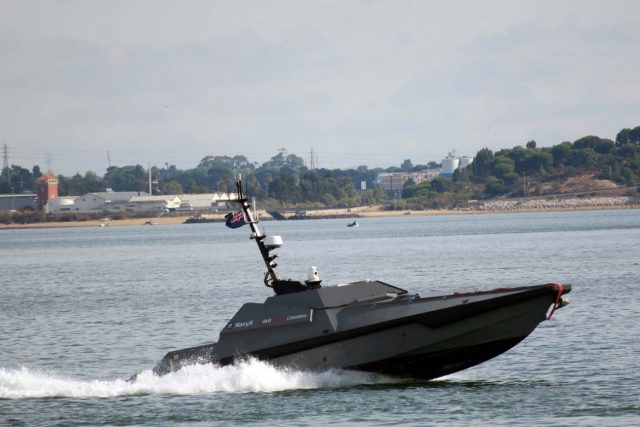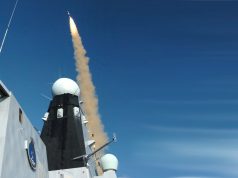The Royal Navy’s autonomous unmanned surface vessel (USV) Madfox launched what is likely a Switchblade loitering missile during NATO’s biggest autonomous war games.
The navy’s innovation experts NavyX deployed to Portugal with unmanned technology for the annual experimentation exercise. The two-week exercise aimed to test the integration of NATO systems and explore existing and new military roles for autonomy.
At the center of the Royal Navy’s contribution was the Madfox USV which has been undergoing trials all year. During it’s first overseas deployment, the boat was tasked with its biggest test to date – being part of a surveillance training operation ending in a missile launch.
For the trial, a Puma drone launched by USNS Carson City relayed information to a land-based control center of a possible target – in this case a simulated target of a Spanish unmanned boat. Once received, that information was sent to the Royal Navy’s Madfox vessel and the missile launched.
The navy did not reveal what kind of missile was launched from the USV. According to video footage shared by the Royal Navy, the missile launched during the drill appears to be the Switchblade loitering munition. The UK was first confirmed as a customer for the weaponized small unmanned aerial system with a March 2021 contract announcement from the Pentagon.
Commander Antony Crabb, NavyX experimentation team leader, said: “The system launch from Madfox was a UK first, demonstrating the potential of uncrewed surface vessels for lethal and other payloads; crucially, the whole serial was commanded, enabled and facilitated using information provided by uncrewed systems.
“It is a significant step for UK/US interoperability and interchangeability.”
Later in the exercise, Royal Navy technology supported night-time amphibious operations. It saw Madfox observe a ‘target’, undetected, and provide live imagery using its onboard cameras.
As Portuguese Marines stormed ashore, aerial drones provided further surveillance, sending imagery to ruggedised tablets within the assault forces. Personnel in the Maritime Operations Centre were able to make an assessment of the target defences and enemy strength before ordering an attack.
The exercise was designed to show how dismounted Command and Control systems could extend situational awareness provided by uncrewed systems to small distributed teams. The tablets also enabled the Marines to request missions from the uncrewed systems connected to the UK MAPLE mission planning system.
During the fortnight of trials, MAPLE provided the means to pass missions to multiple NATO uncrewed equipment in the air, on the surface and underwater.
Through MAPLE, the UK was able to integrate with more than twenty different assets including those from the US, Portuguese, Spanish and Dutch navies.
More than 900 personnel, 70 autonomous uncrewed systems and 11 navy vessels took part in REPMUS.



























